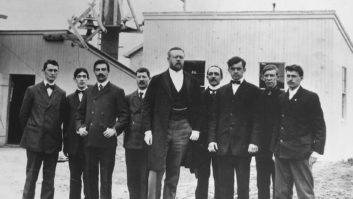Readers expressed strong interest in the story “Fessenden: World’s First Broadcaster?” by James E. O’Neal, which appeared in the Oct. 25, 2006 issue of Radio World. This article is in response to that story.
We commend James O’Neal for his thorough research. Thanks to him and other authors who have commemorated the 100th anniversary of Reginald Fessenden’s now-famous (and possibly mythic) 1906 broadcast, a largely forgotten radio pioneer has received some much-deserved attention.
But the question of whether Fessenden really did make the first broadcast ever on Christmas Eve 1906 is far from settled. Yes, there are the true believers, who insist that whatever was said in Helen Fessenden’s 1940 biography of her husband must not be questioned. And there are a few skeptics who wonder, as O’Neal does, why such a momentous event received so little coverage at the time it occurred — or even years later.
Competing for attention
Chris Sterling and I wondered that too.
While O’Neal was doing his research, Chris and I were undertaking a similar project, writing an article for the Antique Wireless Association Review. In quite a few cases, we found the same information (or lack of it) as O’Neal, but we also found a few things that may shed a bit more light on a situation that may never entirely be resolved.
O’Neal states that he “researched Boston and New York newspapers published during and after the last week of 1906. They yielded nothing.” But when I examined numerous Boston newspapers, I found something more: several possible reasons why neither the experimental broadcast of Dec. 21, 1906, which we know did occur, nor the Christmas Eve broadcast received any play from Boston reporters.
In December 1906, Boston was in the midst of a “telephone war,” a contentious battle in which the monopoly New England Telephone and Telegraph Company was being challenged by the upstart Metropolitan Home Telephone Company. Metropolitan’s executives were demanding the right to do business in Massachusetts, and newspapers were filled with articles about it. Hearings took place throughout the last two weeks of December.
While I cannot read the minds of the reporters, it seems evident that covering the ongoing controversy in Boston was much easier and more exciting than making the long drive down to Brant Rock to cover what Fessenden was doing.
And to make matters worse for Fessenden, several days before Christmas, there was a heavy snowstorm, providing Boston reporters with another reason to avoid making a long trip.
Reporters knew how to find their way to Brant Rock and Marshfield; they tended to show up in the summer to cover wealthy people vacationing there. They also covered hot air balloon races that took place in summer. And it wasn’t that the press had anything against inventors; periodically, articles described interesting experiments and the men (usually men) doing them. In fact, Fessenden received a favorable profile of his long-distance transmissions in the Boston Globe on June 26, 1910. But while many of his achievements were listed, nowhere did the article mention a Christmas Eve 1906 broadcast.
Timeline
We may never know why neither the newspapers nor the British and American engineering journals of that time included any story about a broadcast on Christmas Eve. Fessenden often wrote about his Dec. 21, 1906 broadcast as well as his transmissions in November, and he pointed out how many times he had sent voice by wireless prior to 1906.
On the other hand, when O’Neal asserts, “It appears the legendary date stems from a letter written by Fessenden [to S.M. Kintner] from his home in Bermuda in 1932, about five months before his death,” he is only partially correct.
In that letter Fessenden does indeed tell former colleague Samuel M. Kintner that the Christmas Eve broadcast occurred and it might be considered a “first.”
But a letter of Sept. 8, 1936, that Kintner, now a vice president at Westinghouse, wrote to George H. Clarke offers an interesting clue. Kintner refers to previous correspondence between himself and Clarke. He says that Fessenden’s son has been pursuing the idea of compiling a written record of his father’s achievements, and had asked Clarke and Kintner to help. Reginald K. Fessenden was gathering information for his mother Helen, who was preparing to write a book; he asked Kintner for recollections of Fessenden’s work. Kintner states in this letter that he agrees that Fessenden’s achievements are worthy of being remembered, but “at the time the work was done, I must confess I … didn’t attach any such importance to it.”
Also noteworthy is that four years before the Fessenden–Kintner letters, at an April 1928 talk given at Harvard, Harry P. Davis of Westinghouse credited Fessenden with having been the first to broadcast, on Christmas Eve 1906. This is the earliest mention of the event that we were able to find.
What is interesting about the speech is that Davis tries to establish a timeline, starting with Fessenden as the first broadcaster and leading up to KDKA as the first station (yet another myth, but a durable one). Henceforth, we will see the linkage of Fessenden’s “first” and KDKA’s “first” fairly often, thanks in large part to a wire service reporter name Robert Mack.
His account of the Christmas Eve broadcast, followed by the first broadcast of KDKA, began appearing in various newspapers in early November of 1930. But Mack was no ordinary wire reporter. He was in real life Martin Codel, co-founder of Broadcasting magazine in 1931. He seems to have gotten the Fessenden story from Davis, someone he covered frequently. But the fact that Codel continued to repeat the Christmas Eve story may also suggest that Fessenden himself was telling it to reporters, as were his son and wife, all trying to make sure the inventor’s accomplishments were not overlooked.
Proving a negative
There are other fascinating bits of research that we found, such as information Chris derived from Fessenden’s personal calendar books from 1906 and 1907, neither of which mentions a broadcast on Christmas Eve.
But rather than belabor the point, let us repeat that we mainly disagree with O’Neal’s conclusion. For one thing, it’s impossible to prove a negative, especially a century later. So we don’t know if the broadcast happened. Just because nobody in the media thought it worthy of coverage doesn’t necessarily mean it didn’t occur.
It wasn’t until the mid-1920s that Fessenden’s loyal wife and son took on the task of being his publicists, a task made more difficult by the fact that even some who knew and respected him didn’t recall everything he had done in the early 1900s.
Eventually, Reginald Jr. and Helen won over a popular writer of mass-appeal history books, Alvin F. Harlow, who wrote about the Christmas Eve broadcast in “Old Wires and New Waves” in 1936. With that, the story began appearing much more often, given further momentum when Helen’s biography came along four years later.
We do agree with James O’Neal that Reginald Aubrey Fessenden was a great inventor who pioneered broadcasting. But we can’t agree that the Christmas Eve broadcast did not occur. Our reading of the facts suggests that whether it did or not, it’s a moot point, since he had already accomplished this feat long before Christmas Eve 1906.











